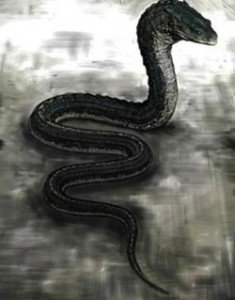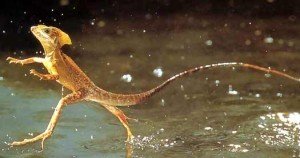You may have heard of a creature called the basilisk from mythology or the Harry Potter series, but few realize that basilisks are real animals.
In Harry Potter and the Chamber of Secrets, the basilisk is a terrifying creature that crawls through the school pipes and turns anyone who catches a glimpse of its eyes into stone. Those who have the misfortune of looking directly in J.K. Rowling’s fictitious beast’s eyes are killed on the spot.
The Legend

Photo Credit: wattpad.com
The basilisk didn’t originate with the Harry Potter universe, however. The myth goes back to ancient Greece, where travelers feared basilisk attacks, and was eventually recorded in European bestiaries. Roman historian Pliny the Elder, Leonardo Da Vinci, Shakespeare, and Charles Dickens all wrote about basilisks before J.K. Rowling.
Some older legends claim basilisks are born from an egg laid by a rooster, and their venom was said to blight the earth when the basilisk moved. Initially, it was said to look like an average serpent. Medieval tales developed the basilisk into a more dragon-like form, adding wings and sometimes feathers.
The myth of the basilisk may have partially originated from tales of travelers who encountered cobras, which are venomous and live in the desert, leading to stories of a serpent that turned that land to an arid waste. In all likelihood, the myth of basilisk isn’t based so much on one real creature as a combination of many.
The Reality
Real basilisks don’t possess the same magical powers as the one in the stories, but that doesn’t mean they’re not fascinating. In real life, basilisks are part of a family lizards (not serpents) that also includes a few types of iguana.

Photo Credit: factzoo.com
The green basilisk lizard, sometimes known as the Jesus Christ lizard, is an animal that lives in the forested areas of Central America. It gets its nickname thanks to an amazing ability to skim across five feet of water per second using its long toes. These specialized toes have flaps of skin that expand in the water, giving the lizard enough surface area to stand without sinking, giving it the appearance of being able to walk on water.
There is more than one kind of real basilisk, however. Besides the green or plumed basilisk there’s the common basilisk, the Western or red-headed basilisk, and the brown or striped basilisk. Hernandez’s helmeted basilisk and the Guatemalan helmeted basilisk also exist under a separate genus – although none of them have been known to turn people to stone.
Every legend is based in fact. However the myth around these fantastic beasts began, the reality of basilisks is almost as fascinating as the stories people have told about them.
Do animals and the study of life fascinate you? Maybe a career in biology is right for you! Or, read on to find out more about pseudoscience and how to avoid it.







Leave A Comment
You must be logged in to post a comment.